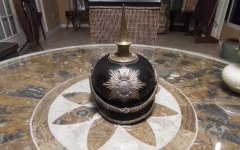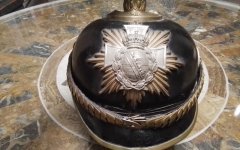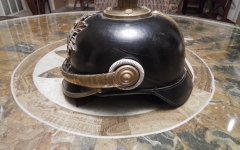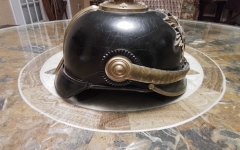USMC-EOD
Active member
Hi,
I purchased this helmet (and a bunch of others) the other day from the estate of an old family friend.
I normally collect enlisted helmets only, but there were several officers helmets there, so I went ahead and took the plunge...
The wappen appears to be for an enlisted reservist. When I removed the chinscales, I found that the enlisted cockades were larger than the type normally found used with the M91 side posts and that they had a small diameter hole in their centers for use with these types of officer chinscales.
All parts have obviously been on this helmet for a very long time. The owner prior to me had purchased most of his collection in the late 1950s through the early 1970s.
I looked through Rankin, Cowen, Trawick and Bowen's books, and went to Tony's Kaiser Bunker site, but could not find anything similar.
Was this helmet put together erroneously by a previous owner?
-or-
Could this be a Fahnrich, Warrant Officer, or NCO helmet? Perhaps something else along those lines?
Any advice or guidance from the more knowledgeable or seasoned members of this site would be greatly appreciated.
Thanks, Bryan.
I purchased this helmet (and a bunch of others) the other day from the estate of an old family friend.
I normally collect enlisted helmets only, but there were several officers helmets there, so I went ahead and took the plunge...
The wappen appears to be for an enlisted reservist. When I removed the chinscales, I found that the enlisted cockades were larger than the type normally found used with the M91 side posts and that they had a small diameter hole in their centers for use with these types of officer chinscales.
All parts have obviously been on this helmet for a very long time. The owner prior to me had purchased most of his collection in the late 1950s through the early 1970s.
I looked through Rankin, Cowen, Trawick and Bowen's books, and went to Tony's Kaiser Bunker site, but could not find anything similar.
Was this helmet put together erroneously by a previous owner?
-or-
Could this be a Fahnrich, Warrant Officer, or NCO helmet? Perhaps something else along those lines?
Any advice or guidance from the more knowledgeable or seasoned members of this site would be greatly appreciated.
Thanks, Bryan.




